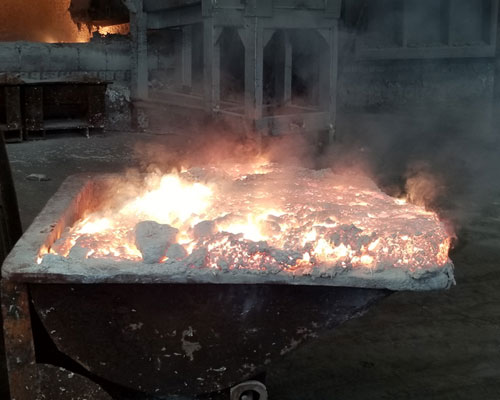Refining process of aluminum alloy is an important step in aluminum alloy casting. Flux is usually used for refining in the furnace. According to the melting of the crucible and the weight of the charge, the charge, alloy ingot, master alloy and pure metal are added to the crucible one by one or at the same time, and heated to melt them. When magnesium is added, the magnesium block is pressed into the lower part of the alloy liquid with a bell shaped cover, slowly rotated and evenly stirred, and then all magnesium is melted and the bell shaped cover is taken out.
After the charge is completely melted, when the alloy liquid temperature reaches 690 ~ 740 ℃, press the refining flux into the alloy liquid in two or three batches (10 ~ 15cm away from the bottom of the crucible) with bell shaped cover, rotate slowly until the reaction stops, and then take out the bell jar. When the weather is humid or the amount of reheating material is large, the upper limit of refining flux dosage depends on the refining effect.
After the refining process of aluminum alloy, it is allowed to stand for 10-20 minutes, then the slag on the surface of the alloy liquid is removed, and then the alloy liquid is transferred to the holding furnace or directly cast. During the whole melting and casting process, the temperature of alloy liquid should not be too high and should not exceed 750 ° C in a short time.

The melting and pouring time of alloy should be shortened as much as possible, and should not exceed 8 hours from the beginning of alloy melting to the completion of pouring.
The residence time of refined alloy liquid after casting or die casting shall not exceed 4h, otherwise, it shall be supplemented with refining.
The refining temperature is the same as the casting temperature. The amount of refining flux is 0.2-0.4% of the residual alloy liquid weight. The loss of magnesium should be increased in refining mg Al alloy.
In the casting process, do not add the residual material of gate or waste casting to the alloy liquid at will, otherwise it should be refined again.
When the depth of the remaining alloy liquid at the bottom of the crucible is less than 50 mm, it can not be casted again, but it can be continuously melted by adding charge or poured into new alloy liquid.
During the whole melting process, it is necessary to minimize the damage to the oxide scale on the surface of liquid alloy. When shoveling the alloy liquid, the oxide scale should be removed first, so as to avoid putting the oxidation zone into the alloy liquid.

